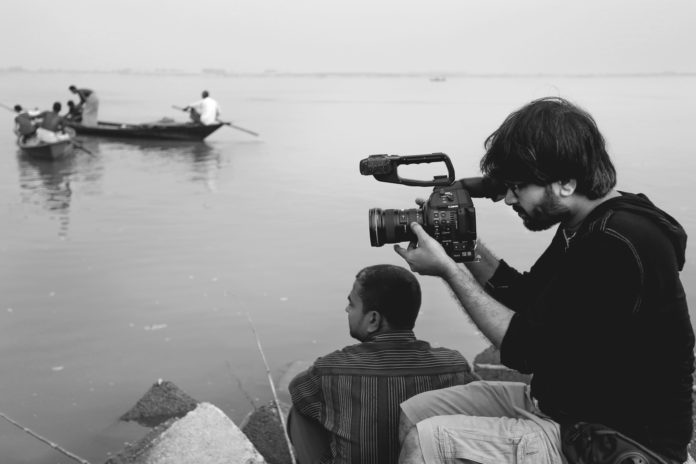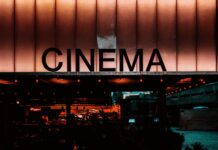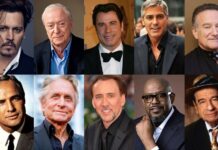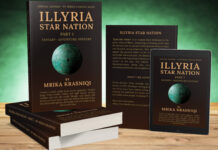Exclusive interview with Shahadat Hossain – Film producer
Shahadat Hossain is a film production expert with more than ten years’ experience working on international and domestic media projects as a director, cinematographer, producer and photographer. He has worked for Lotus Films (Austria), Komola Collective (UK), Unicef Bangladesh, Mortal Coil Media (UK), VG Network (Norway), Bishari films (Canada) and Big Blue Communications. He also worked as a cinematographer of the Rana Plaza documentary by Norway Television and consultant filmmaker for the Office of the High Commissioner for Human Rights (OHCHR). Shahadat has worked as a cinematographer in five feature documentary films and many short films and commercials.
Shahadat is the Director of Photography for Leesa Gazi’s feature documentary ‘Rising Silence’ following the lives of the survivors of mass rape that occurred during the 1971 Liberation War of Bangladesh. The film won the Best Documentary Award at the Dhaka International Film Festival in January 2019 and is 2019 Moondance Winner in the feature documentary category. It also won the Asian Media Award for Best Investigation 2019 in the UK. Recently Rising Silence has won Award Of Merit 2020 with Special Mention by The Accolade Competition.
Shahadat is currently working on the feature documentary Different Border based on the lifestyles of transgender individuals in Bangladesh, India and Nepal.
Shahadat started his career as a freelance photographer in 2005 and since then has received more than twelve international awards and participated in twelve international exhibitions in the US, UK, Japan and beyond. Shahadat has also worked with prominent European documentary filmmaker Michael Glawogger. He did his MA in English Literature and completed a Post Graduation Diploma in cinematography from The Asian Academy of Film and Television, India.
NY Glam: How did you get started in your career?
I was not that kid who shot movies or taking photographs; actually, I didn’t have access to these things, and no one could ever think a boy could devote himself to photography or Films. Throughout my boyhood, I did not have access to filmmakers, their work, or even a camera. So movies did not exist for me in theory or in practice. In 1998 after the school exam we couple of friends went to the sea town Cox’s Bazar and I took charge of the camera, and that’s how it all started. I’m a self-learned photographer, and around 2004/2005, I started my career as a freelance photographer. After a few years, I found myself into documentary movies with an Austrian company in super 16 mm formats in 2009.
NY Glam: What is your experience shooting with different tools? What are you to go to gadgets?
It’s all about how you read the story and how you tell the story and how you reveal the critical emotions, and that shapes your approach when it comes to operating a camera and finding your moments. I always use my i phone for the reference frame, and I use Canon 6D and set of lenses such as 24-70 mm, 70-200mm, 35mm, 50 mm and Zorki film camera with 50mm lens for photography and Sony FS-5 and FS-7, Sony a7s iii and Gh-5 for regular video production and low budget production. For commercials, I prefer Alexa.
NY Glam: Which specific requirements did you have to take care of when choosing your equipment?
Each production requires a different set of things to imply. So better go with a free approach and decide based on the requirements and also to keep the best things within the budget is the best approach without compromising the creative demands. Choosing equipment for a project is a mix of deciding what we can afford to rent and what kind of equipment works for the scenes we have to film. The Alexa has been used in almost every Ad films here since digital cinema cameras were introduced because the images it produces have rich and deep skin tones and a film-like quality to the highlights and shadows.
When it comes to lighting equipment, LEDs have become very handy. They are cheap and can offer high output and colour quality. But for ‘Rising silence’ we keep a couple of LED lights with adjustable colour temperature with us, and they were handy in different places, and they were budget-friendly as well as easy to carry and use.
We use jib for the train shoot in Dhaka. We used GoPro quite a lot for the landscape shots whereas managed the c-100 for most of the handheld shots with the characters, and Canon XF-205 camcorder was used for the wide shots. In Kolkata, we had a minimal resource and were heavily relying on Canon 6D with a set of lens and natural light sources.
NY Glam: What are you currently working on?
I am currently working on my feature documentary film ‘Banishanta’. ‘Banishanta’ is a narrative documentary about three young sex workers, a Veteran Madam and a male client for all seasons. The Banishanta Island, between Sunderbans and Mongla port, consists of 150 women, all dependent on the sex trade inside a state-licensed brothel in Bangladesh.
NY Glam: Did you like the script?
We didn’t have any script per se, but we had an overview of the story, the women we were going to meet and a detailed guideline in regards to our approach to the story. We also used to have a meeting every morning to discuss the next shooting schedule and to decide which aspects of the story we would shoot next.
We stayed with each of the women/stories for a few days to understand and capture their way of life in their own settings. When we were travelling from one place to another, I would think about the location we were visiting next and tried to get as much B-roll as possible to feed into the editing table which became handy in the end.
NY Glam: Did you have a particular shooting approach when making this film?
When it comes to fiction you have to break down the script and kind of rewrite the script in your own way, but for a documentary film it is different, and it depends on the type of the film you are working on and whom you are working with. Every documentary filmmaker has his/her own perspective and approach towards a story, and our job is to understand and deliver that vision most efficiently. When it comes to making a frame or composition, I always prefer to keep the idea of a single frame that tells a story. For ‘Rising silence’ we knew all along that it’s going to be a presenter lead documentary with mixed of sitting interviews. So I tried to complement their stories with visually moving shots and naturally beautiful footage with cine-variety style in the b-roll section so that it would look appealing to absorb these heartfelt stories of the Birangona women of war. That’s why natural landscape played a significant role in the movie.
NY Glam: Was there a scene in the film that was particularly challenging from conception to actual execution?
I would say two scenes in the film were particularly difficult to take – the first one was a market scene in the three sister’s story. It was particularly challenging because there was a huge crowd following us everywhere in a dense market place, and we barely had room to squeeze in to find a space for us to continue filming.
In Bangladesh, while we were taking interviews of women in different locations, most of the time, they would not want to open up in our presence. So, we used to set up the cameras and leave, and it was suitable for the crew. But in Kolkata, Jharna Basu did not have any objection telling her story in front of us, and we kept on listening to her heartbreaking testimony while filming. It was intense.
NY Glam: What was the atmosphere like on the set?
In ‘Rising Silence’ it was quite a challenging schedule for the crew. We were on the road, and we were shooting for five weeks on the trot without a major break. However, we had a small unit, and the production in-charge very well managed it. Everyone at the set was committed and on time. The Birangonas were superb with their excellent spirits, good humour and love, which made our life easy as it was a very challenging subject to shoot. So I think our director did a terrific job to tie the knot. Let me tell you one thing it was total teamwork. For an example, while we were taking interviews, mostly we would set the camera and leave as the character would find it difficult to talk in front of us especially being men and I speak the same language as them. So I would set the cameras, lights and looks of the shot and leave it to the designer to see it’s recording alright. Everyone was quite helpful, and I must say it was a small team but a dream team.
NY Glam: How do you define the role of cinematographer?
Typically, a cinematographer is the head of the camera and lighting department to control lighting, framing and composition. Ideally, cinematographer tries to translate ideas into images; his/her job is to tell stories within the time and space on the screen. In cinematography, the most important thing is light that creates the mood. It is much more than just recording what happens on location. It is a language that is not spoken but seen.
NY Glam: What have been some of your recent/other projects?
The feature documentaries I have worked on are ‘Rising Silence’ (released in 2018), ‘In Search of Bengali Harlem’ (shot in 2015, 2017), Bangla Surf Girls (Shot in 2017), ‘Untying the knot’ (released in 2018), Different Border (shot in 2015 and 2016 and about to release in 2021). I have also worked on commercials, and shots and am currently working with the United Nations High Commissioner for Human Rights as a consultant filmmaker.
NY Glam: How do you choose your movies that you want to shoot?
The script is all I need to look at when it comes to feature films; if it is meaningful to me, I’m up for it. And for a documentary film, the power of an idea is all to execute. If the director and I communicate well and understand my requirements, then it’s always wonderful to be part of it.
NY Glam: What are your preferred shooting locations?
I have been privileged to shoot all over Bangladesh and some part of Asia and Europe. From big cities to small villages, big shooting studios to tiny alleys. Hilltowns to beach towns, refugee camps to the presidential palace. It has been incredibly inspirational and fun, but at the end of the day, the best location is the one that goes with the script most.
NY Glam: Is there a film or film maker that inspired you to pick up a camera?
Many great filmmakers inspire me through their work, such as Abbas Kiarostami, Akira Kurosawa and De Sica’s work is full of compassion and honesty. I think their incorruptible quest for truth and reality is striking and exciting. When it comes cinematographers, I am blown away by the work of Raoul Coutard, Emmanuel Lubezki and Subrata Mitra.
NY Glam: Describe your biggest accomplishment to date?
I think survival and being able to love and loved by others is the most significant accomplishment to date, and I must say this love is a miracle.
NY Glam: Do you ever think about directing someday?
I think it is essential to know how to direct when we operate a camera and interact with characters. I love the role I do behind a camera, but I believe everyone has a story to tell, and I do have my stories to tell. Perhaps someday if I got the chance, I will wear a director’s hat.
NY Glam: What are some of the projects that you are working next? Who are you working with?
I am planning to shoot a full-length fiction by the end of November 2020 in Leesa Gazi’s next film, and we are very excited about it. I am going to shoot shorts soon after the lockdown is over and a couple of company AV and I am looking forward to it.
Views: 661






